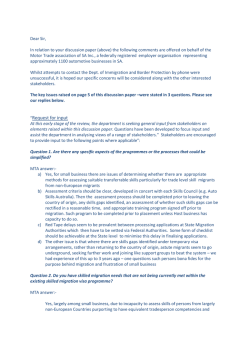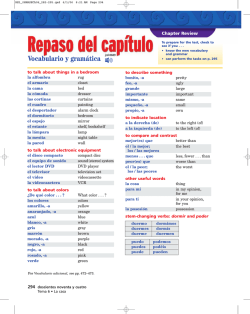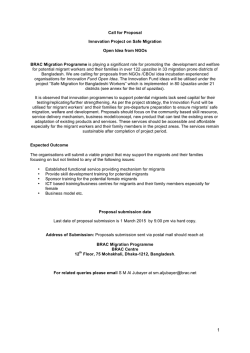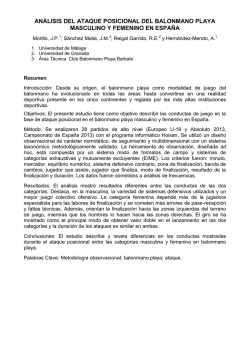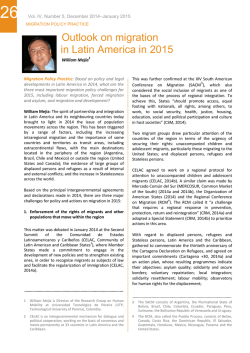
Corporate Social Responsibility, Human Rights and Discrimination
Daena: International Journal of Good Conscience. 9(3)205-211. Diciembre 2014. ISSN 1870-557X Corporate Social Responsibility, Human Rights and Discrimination Responsabilidad Social de las Empresas, Derechos Humanos y Discriminación Abreu, Jose Luis & Batmanghlich, Cameron Abstract. The concept of corporate social responsibility (CSR) is generally understood to mean that corporations have a degree of responsibility not only for the economic consequences of their activities, but also for the social and environmental implications. This is sometimes referred to as a ‘triple bottom line’ approach that considers the economic, social and environmental aspects of corporate activity. Human rights are relevant to the economic, social and environmental aspects of corporate activity. For example, labor rights requiring companies to pay fair wages affect the economic aspect. Human rights such as the right to nondiscrimination are relevant to the social aspect. And the environmental aspects of corporate activity might affect a range of human rights, such as the right to clean drinking water. This research shows that while the primary responsibility for the enforcement of international human rights standards lies with national governments, there is a growing acceptance that corporations also have an important role to play in human rights and the fight against discrimination. The study proves that corporations impact on human rights and discrimination in significant ways. These impacts have increased over recent decades as the economic might and political influences of corporations has grown, and as corporations have become more involved in delivering services previously provided by governments. A wide variety of voluntary and international initiatives that have been developed by individual companies, industry bodies, ngos, inter-governmental bodies and multi-stakeholder groups are exposed in the research results. These initiatives include voluntary guidelines and codes of conduct, monitoring and reporting procedures, and socially responsible reporting indexes. Keywords. CSR, Human Rights, Discrimination, Certifications, Migration. Resumen. El concepto de responsabilidad social empresarial ( RSE) se entiende generalmente en el sentido de que las empresas tienen un grado de responsabilidad no sólo por las consecuencias económicas de sus actividades , sino también por las implicaciones sociales y ambientales . Esto se refiere a veces como un enfoque de triple bottom line que tenga en cuenta los aspectos económicos, sociales y ambientales de la actividad empresarial. Los derechos humanos son pertinentes a los aspectos económicos, sociales y ambientales de la actividad empresarial. Por ejemplo, los derechos laborales que requieren las empresas a pagar salarios justos afectan el aspecto económico. Los derechos humanos como el derecho a la no discriminación son relevantes para el aspecto social. Y los aspectos ambientales de la actividad empresarial pueden afectar a una serie de derechos humanos, como el derecho al agua potable. Esta investigación muestra que si bien la responsabilidad principal de la aplicación de las normas internacionales de derechos humanos recae en los gobiernos nacionales, hay una creciente aceptación de que las empresas también tienen un papel importante que desempeñar en los derechos humanos y la lucha contra la discriminación. El estudio demuestra que las corporaciones impacto en los derechos humanos y la discriminación de manera significativa. Estos impactos se han incrementado en las últimas décadas como el poder económico y la influencia política de las corporaciones ha crecido, y como las corporaciones se han involucrado más en la prestación de los servicios anteriormente prestados por los gobiernos. Una amplia variedad de iniciativas voluntarias e internacionales que han sido desarrollados por empresas individuales, organismos de la industria, organizaciones no gubernamentales, organismos intergubernamentales y grupos de múltiples partes interesadas están expuestos en los resultados de la investigación. Estas iniciativas incluyen directrices voluntarias y códigos de procedimientos de conducta, supervisión y presentación de informes, y los índices de presentación de informes de responsabilidad social. Palabras Claves. RSE, Derechos Humanos, Discriminación, Certificaciones, Migración. 205 Daena: International Journal of Good Conscience. 9(3)205-211. Diciembre 2014. ISSN 1870-557X INTRODUCTION Due to conditions of inequality and marginalization in which millions of people remain unprotected and unsatisfied with their basic survival needs, in Latin America there is a large population that made up various destinations in the world. These groups of Latino immigrants today have found that they can not pursue opportunities in European countries or in the United States, which were their traditional uses. These countries have dramatically closed their doors including migratory ignorance in the process of international migration agreements and human rights work. This scenario has led Latinos to think in nearby territorially and culturally destinations. Ironically, the cultural proximity is not an obstacle for the rape on a daily basis of the human rights of migrants in their own region. Given the bleak outlook facing migrants in Latin America, new solutions and possibilities must be identified. This study recognizes that if companies take on important challenges of the principles enshrined in international labor standards, these could play an important and positive role. For example, the Global Compact provides some of the most crucial standards, among others, which properly considers human rights principles. These principles are derived from the Declaration of the International Labor Organization (ILO) related to fundamental principles and rights at work. This study is primarily intended to inform and reflect on the current situation of human and labor rights of Latino immigrants, raising several possibilities of CSR that are available as models to carry out practical solutions to the complex problems previously expressed. MIGRATION AND DISCRIMINATION IN LATIN AMERICA It is very noticeable, according to a study by Rivera (2001) that current economic models in the world are contained by strong ideologies that feed on the competence of individuals, labor flexibility, excessive consumption and a strong technology insertion relatively standardized. However, these models do not represent processes that lead to the excellent instrumental and technological development to produce tangible improvements in the population. In the opposite way, to observe the social and cultural processes that define this era is necessary to point out the national and ethnic conflicts, the increasing violence and exclusion and diffusion of essentialist arguments based on assumptions of ideologies that negatively valued identities, separate and determine the common coexistence of others, undesirable, foreigners, strangers, migrants [1]. In Latin America there are a number of public speeches, plans, programs, policies and project demonstrations expressing a caring and motivating picture of migration issues. All these factors are related to globalization, the need for integration into the global system and global interdependence. In this sense, the processes of regional integration and free trade, related to free movement of persons and the existence of supranational legal powers have been widely publicized facets by different governments in Latin America [1]. 206 Daena: International Journal of Good Conscience. 9(3)205-211. Diciembre 2014. ISSN 1870-557X However, there are acts of intolerance, discrimination and racism of those who are victims or spectators, immigrants. This confirms that it has been going through a contradictory and paradoxical stage of ideologies that construct contained an exclusionary, unfair and hub model of wealth in few hands. Thus, the promotion of integrationist benefits spreads more like a desire for public and private interests and presentation of market expansion and not as an opportunity to generate intercultural Latin coexistence based on respect for human rights, tolerance, and a culture of peace and democracy [1]. The countries hosting migrants begin to have problems when the hire of such foreign workers are immersed in repetitive crisis of the established models, they do not have sufficient capacity to generate employment for the native population. In this context, the lack of job security and high unemployment suffered by Latin American countries, become the best excuse to justify the rejection of migrants who are taken as a danger to the few sources and opportunities for work. In these scenarios racist, xenophobic, discriminatory and intolerant attitudes are strengthened and coupled with a speech full of nationalism. By identifying the culprits, in this case migrants or displaced presenting different aspects of identity, a set of social imaginary that reject the relevance and prosperity of the integration processes are activated, and at the same time, national scenarios emerge of social and cultural discrimination that exceed state possibilities to solve this problem. An important part of migrant populations have refocused their efforts on migratory nearby neighbors within the same region countries. This is verifiable by registering an increase in arrivals of migrants to these countries, an increase in the migration of the same inventory and low flow recorded in developed countries. Several countries in the region regained the ability to receive migrant populations. For example, Argentina and Brazil, managed to improve its economic performance and thereby generating opportunities for the inhabitants of the countries in the region, especially those who have a greater penetration in the country. This is the same case of Chile, which showed, for more than a decade, a positive economic performance in the region, with excellent improvement in macroeconomic variables [2]. The preferred countries for international migration fell into a deep economic and social crisis, and lost the ability to attract and integrate immigrant populations. For this reason, since the early 2000s and especially since 2008, a series of migration policies with restrictive purposes have been designed and put into practice, with the goal of limiting immigration and residence of foreigners, and to punish with stricter penalties irregularly staying migrants in those territories [2]. The economic and social crisis which disturbs developed societies that serve as a destination for migrants, manifested as a result of the decline in economic productivity, the poor state of labor markets, employment opportunities and the erosion of social benefits, has caused a significant reduction in output to other destinations in South America and has even been an increase in the return to places of origin of migration. 207 Daena: International Journal of Good Conscience. 9(3)205-211. Diciembre 2014. ISSN 1870-557X MIGRATION AND HUMAN RIGHTS Migratory mobility processes are inherent to the behavior of mankind. Migratory movements, their causes, development and consequences, either intentionally or unintentionally changed the demographic nature of the current nations and stimulated significant changes in the workplace, social, cultural and economic fields. At present it is estimated that the number of migrants in the world surpasses 215 million people, equivalent to 3% of the world population and is twice the number of registered migrants in 1970. The migrant is ranked as vulnerable in regard to human rights person, it is strongly characterized by the risks and dangers that must face. This is evident in reports by the United Nations, the International Organization for Migration (IOM) and the Organization of American States (OAS) indicating that migrants are exposed to a series of attacks, such as the absence of due process, arbitrary arrests, mass deportation, inhumane conditions of detention, exploitation, forced labor, etc. Leaving the jurisdiction of their country of origin in which they are residents, migrant individuals face a situation of great vulnerability due to inequality experienced in relation to national residents of the country of arrival. Migration produce an atmosphere of tension between the nationals of the receiving country and migrant communities by encouraging the emergence of labor, social and racist prejudices that make them vulnerable migrants and hinder the integration of migrants into society of the receiving country. Being different in culture, language, customs, and physical features compared to the host country, migrants are victims of rejection, hostility, discrimination and intolerance on the part of the societies in which they live and toil, to which is added a sense of abandonment prompted by the remoteness of the family and the lack of practice of their customs and their way of life. States have the sovereign right to develop their political work and migration, however, we must consider the need to effectively manage labor migration processes for consistent and fair protection of migrant workers national policies. CSR & DISCRIMINATION OF MIGRANTS Recent studies that aimed to explain the role of CSR in discrimination highlights: "That's how we got to approach the workplace where discrimination is accentuated in principle reinforced by the lack of equal opportunities in access to education, essential to entry into the labor system. In reference to work, this is perhaps the most developed dimension of CSR due to early identification of internationally accepted standards. Labor standards of the ILO formulated in 1919 and the Universal Declaration of Human Rights of the United Nations are considered the base" [3]. The four ILO fundamental principles and rights at work are [3]: 1 Respect for freedom of association and the effective recognition of the right to collective bargaining. 2 The elimination of all forms of forced or compulsory labor. 3 The 208 Daena: International Journal of Good Conscience. 9(3)205-211. Diciembre 2014. ISSN 1870-557X effective abolition of child labor. 4 And eliminating any discrimination in respect of employment. The Global Compact is a voluntary initiative, promoted by the United Nations, in which companies are committed to aligning their operations and strategies with ten universally accepted principles in four areas: human rights, labor standards , environment and anti-corruption. On the number of participants, six thousand in over 135 countries, the Global Compact initiative is the world's largest corporate citizenship. The Compact is a framework for action aimed at building the social legitimacy of corporations and markets. Companies that adhere to the Global Compact share the conviction that business practices based on universal principles contribute to building a more stable, equitable and inclusive global market that promote more prosperous societies [4]. Companies, trade and investment are essential pillars for peace and prosperity. But in many areas the companies are linked to serious dilemmas, such as exploitation, corruption, inequality, and other barriers that discourage innovation and entrepreneurship. Responsible business actions build trust and social capital, while contributing to development and sustainable markets. In this sense, the Ten Principles of the Global Compact are based on Universal Declarations and Conventions applied in four areas: Human Rights, Environment, Labor Standards and Anticorruption. The ILO Multilateral Framework on Labour Migration proposes to strengthen CSR activities in the countries of Latin America. The ILO "should promote and protect the human rights of all migrant workers, regardless of their situation . In particular, all migrant workers should enjoy the rights and principles contained in the ILO Declaration on Fundamental Principles and Rights at Work and its Follow-1998, which are reflected in the eight fundamental ILO Conventions, and relevant UN conventions on human rights." The ILO ensures that all international labor standards apply to migrant workers, unless otherwise indicated. The national legislation on labor migration and protection of migrant workers should be guided by international labor standards that apply and other relevant international and regional instruments. The ILO model integrates a broad set of principles, guidelines and best practices on policy on migrant workers, which is derived from the relevant international instruments and a comprehensive review of labor migration policies and practices constituents [5]. The OECD Model presents non-binding principles and standards for responsible business conduct in the global context, in conformity with applicable laws and internationally recognized standards. Their guidelines are a code of responsible business conduct, comprehensive multilaterally agreed that governments have pledged to promote. The OECD model states that in the context of the legal and regulatory provisions and practices in employment and labor relations as well as international labor standards that may apply, companies must be guided to their activities, on the principle of equality of opportunity and treatment in employment and not discriminate against their employees in employment or occupation on the basis of race, color, sex, religion, political opinion, national extraction or social origin, or any other circumstances [6]. The Model International Organization for Migration uses the instruments proposed in the manual tools and best practices in public labor migration policies that help 209 Daena: International Journal of Good Conscience. 9(3)205-211. Diciembre 2014. ISSN 1870-557X the user develop or increase the ability to plan and implement policies labor migration under a comprehensive system. The successful model proposes policy options that have been implemented in some Latin American countries, the continent and beyond, to manage the deployment of workers to other territories. The model is segmented into seven core modules for the development of labor migration policies: policy framework, legal framework, institutional framework, data collection and analysis, recruitment, human resource development and external market, and support services [7]. CONCLUSION The study shows the need to influence the corporate culture in order to sensitize companies to avoid discrimination against Latin immigrants in all aspects, especially in the context of the workplace, where no doubt it is in especially malignant. As has been observed, overviews of the existing discrimination of migrants in Latin America has been presented, and have provided lines of action based on international models for promoting a culture of non-discrimination. This effort coincides with the point made by another researcher in that "in recent international forums on human development or sustainable development has emerged a consensus on the fundamental role of business in poverty eradication and development of social cohesion, among other issues. Also, the increasing pressure from NGOs, through campaigns to denounce human rights violations in multinational companies, has highlighted the importance of business in the fight for the respect of human rights" [8]. From the concept of CSR the companies should be seen as social agents, to act from their field of influence to support and promote respect for human rights of migrants. CSR models in Latin America should be applied to ensure equality of opportunities and treatment without discrimination against its employees, shareholders, customers, suppliers, but especially the vulnerable minority groups of migrants. Within these reflections is particularly important the management of cultural diversity as one of the great challenges of CSR models existing in Latin America. The management of cultural diversity in business has been defined as the set of actions that make profitable the presence of immigrant workers in the company, with an added value of the human resources policy [9]. CSR should take into account factors correlated with migration processes in organizational cultures and seek ways to facilitate the management of human resources in order to achieve better integration and coexistence among the various employees of the company. The challenge is not perceived as a simple task, however, there are excellent tools that can facilitate international category management of this active human migration. CSR should be established as a fundamental model to service management protection of Latin immigrants, who with their cultural diversity enable the organization to enrich their social and human rights dimension. This process of integration of migrant labor involves the creation of important shared values based on the appreciation and understanding of cultural differences and promoting Latin American justice and equality. 210 Daena: International Journal of Good Conscience. 9(3)205-211. Diciembre 2014. ISSN 1870-557X REFERENCES [1] Rivera, Freddy. 2001. Migrantes y Racismo en América Latina: dimensiones ocultas de realidades complejas. CEPAL Comisión Económica para América Latina y el Caribe. IIDH. Instituto Interamericano de Derechos Humanos. Reunión de Expertas sobre Racismo y Género. Santiago de Chile, 4 y 5 de junio de 2001. [2] Texidó, Ezequiel & Gurrieri, Jorge. 2012. Panorama Migratorio de América del Sur 2012. Organización Internacional para las Migraciones (OIM). Oficina Regional para América del Sur. ISBN - 978-92-9068637-8. [3] Cormick, Ana María. 2012. ¿Qué rol tiene la RSE en la discriminación? en Abreu, José Luis et al. Paola Lattuada [Ed.], Hernán Carlos Bustamante García. Responsabilidad social empresaria: miradas plurales, un interés singular. [Comp.] Medellín : Ediciones UNAULA, 2012. 260 p. (Pensamiento Latinoamericano). ISBN : 978-958-8366-57-9 [4] Organización de las Naciones Unidas (ONU). 2013. Pacto Mundial de la Organización de las Naciones Unidas. http://www.unglobalcompact.org/Languages/spanish/index.html [5] Organización Internacional del Trabajo (OIT). 2007. Programa de Migraciones Internacionales. Marco multilateral de la OIT para las migraciones laborales. Principios y directrices no vinculantes para un enfoque de las migraciones laborales basado en los derechos. Ginebra, Organización Internacional del Trabajo, 2007. ISBN: 978-92-2-319118-4 (print) & 978-92-2-319119-1 (web) [6] OCDE (2013). Líneas Directrices de la OCDE para Empresas Multinacionales, OECD Publishing. http://dx.doi.org/10.1787/9789264202436-es ISBN 978-92-64-20242-9 (impresa). ISBN 978-92-6420243-6 (PDF) [7] Organización Internacional para las Migraciones (OIM). 2010. Políticas Públicas sobre Migración Laboral. Herramientas y buenas prácticas. ISBN: 978-92-9068-589-0 [8] Bornot Crébessac, Sophie. 2005. La Discriminación en Las Empresas. Colección “EMPRESA INCLUYENTE”. Consejo Nacional para Prevenir la Discriminación. ISBN 970-9833-20-0. [9] Salcines Correa, Alfredo. 2011. Responsabilidad Social Corporativa e Integración de Personas en Riesgo de Exclusión Sociolaboral. Instituto Europeo para la Gestión de la Diversidad. CEOE CEPYME Cantabria. www.ceoecant.es [10] For a journal paper: author(s), (year), paper title (in quotes), journal name, volume and issue numbers, page numbers (inclusive). [11] For a proceedings paper or chapter in an edited book: author(s), (year), paper or chapter title (in quotes), volume title, editor(s), volume number (if applicable), publisher, city, page numbers (inclusive). [12] References should be cited in numerical order and according to their order of appearance. They should be numbered and enclosed in brackets. [13] In the case of two citations, the numbers should be separated by a comma [6,7]. In the case of more than two references, the numbers should be separated by a dash [8-10]. 211
© Copyright 2025
